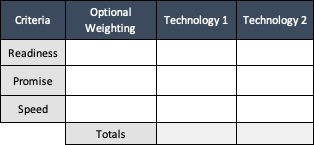Evaluating Early-Stage Technologies
Summary
In the context of new technology commercialization, there is no silver bullet to pick winners among new technologies. The established way is expert evaluation, diving into each technology to establish merit and identify redeeming qualities. The process is time-consuming and does not scale well to large pools of applicants. Another challenge is comparing technologies that appear similar at face-value. Developing custom indicators that focus on key success factors may be a way to speed evaluation. This is by no means intended as a substitute of expert evaluation, but rather as a complementary resource.
Getting a Sense of Readiness
Two types of readiness: A) Developmental maturity - How ready is the technology to be deployed and go to market? B) Readiness for market adoption - How ready are customers to embrace the new technology? A custom scale could be developed for either based on existing frameworks like TRL (NASA) or TRI (Dr. Parasuraman, Univ. of Miami).
Getting a Sense of Promise
How can we get a sense for the expectations, opportunities, strengths, and potential of the technology? An indicator along these lines is tricky but not impossible, most probably through ranking by a subject-matter expert. Things that could help: A traditional SWOT analysis, clear articulation of pain points and value proposition.
Getting a Sense of Speed
How to get a sense of 'developmental momentum' of a technology? A Moore's-law style approach can be applied to other domains by finding one or more key metrics that speak to the state of development and tracking their improvement through time. A classic example is tracking the historical rates of improvement in photovoltaic cell efficiency.
 A developmental history of PV solar cells.
A developmental history of PV solar cells.
Pugh Matrix (Weighted Decision)
Once assessed, custom indicators can be reconciled using a simple matrix where each indicator is weighted according to established priorities.
 Power in simplicity.
Power in simplicity.
Measuring Complexity
Getting a sense of 'complexity' can also be useful to evaluate a technology. Higher complexity can make it hard to obtain predictable outcomes. Measures of complexity tend to be context-specific. The most generalizable methods come from disciplines like systems engineering which measure complexity by counting numbers of parts, modules, and interfaces. Establishing a ruling aspect to assess complexity can be awkward and challenging. The suggestion is to rely on developmental speed as a proxy indicator for complexity.
✎ Connection to
Key / Elements of New Technology Development